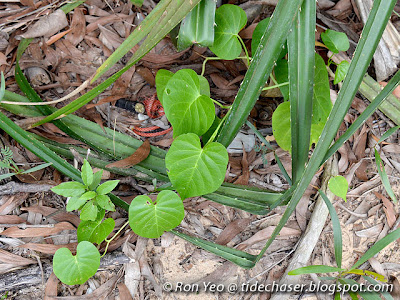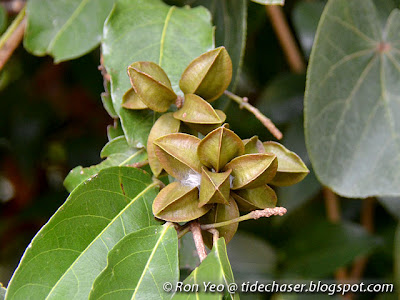I had not been blogging much about the various activities that I was involved with these days, but decided to blog about this as I think the HSBC volunteers who came for the Semakau coastal cleanup really did a commendable job! :)
Semakau is definitely one of the more challenging sites to do a beach cleanup - not that the cleanup itself is tough, but after the cleanup, the participants have to carry the trash and walk a few hundred metres to reach the main road! This time round, we only had 25 volunteers, but they managed to pick up more than 250kg of trash, meaning on average each volunteer had to carry more than 10kg of trash. One of the teams with 5 volunteers actually collected more than 90kg of trash, so averaging out each person had to carry close to 20kg! Anyone reading this who felt that 20 kg was not a lot could try carrying two 10kg dumbbells and walk one round around a sports stadium - and mind you, you have to carry them with your hands, not in your bag. Not to forget that the volunteers had to walk for a few hundred metres under the blazing sun along the sandy beach followed by an uneven forest trail with several fallen trees...
Anyway, back to the cleanup proper. As the tide was high in the morning, we did the cleanup in the afternoon instead. After we reached the island and did the briefing, we took the buses provided by NEA to the entrance of the coastal forest.

Semakau had its own special way of welcoming the volunteers, covering the forest trail with a red carpet of fallen Sea Almond (Terminalia catappa) leaves.

The bad weather over the past few months had resulted in several fallen trees at the beach, and some of the volunteers had to crawl under the trees and shrubs to get the rubbish.

After the cleanup and the trek back to the main road, the volunteers had to weigh the trash they had collected and record it in the data sheet. From their shadows, you could tell that it was still hot and sunny.

And finally, the contractors arrived with the truck, and helped us with the loading of the trash onto the truck. Special thanks to NEA for providing the buses on the island, arranging for the contractors to collect the trash, and providing the water for cleaning up!
And perhaps it was to reward the volunteers for their hard work, we had a number of interesting sightings along the way!

This was my first time seeing the rare Camacinia gigantea on Semakau! Not sure if this is a new record for the island, though it's not listed in the first Semakau book by NEA, and I don't have a copy of the second edition to double-check.

This was also my first time seeing a Beach Moonflower (Ipomoea violacea) on Semakau as well, even though it's a very young one. The only other place which I had seen this was on Pulau Senang. Recently, I just found out that several of my botanist friends had never seen this before. This species actually has white flowers that blooms at night, and is a beach species, and hence most of the other morning glory species identified as this species but seen further inland could have been wrongly identified. Read from a website which highlighted that even many botanists around the world misidentified this species, and hence various research done on so-called "Ipomoea violacea" could actually be other species. As a result of all these confusion, its current conservation status was unfortunately put down as "common" in Singapore, though it probably deserved a "critically endangered" status for its rarity!

I was also very lucky to chance upon yet another patch of the critically endangered Seashore Bat Lily (Tacca leontopetaloides) along the coast! The original patch was doing badly due to the eroding shore, so I was already very happy when I chanced upon a second patch early last year, and now, a third one! And one of them was even blooming!

Another critically endangered plant that was flowering was this climber, Anodendron candolleanum. The flowers occur in bunches, and were really tiny!

And believed it or not, yet another critically endangered climber, Psychotria sarmentosa, was also flowering! And not only that, there were many young fruits as well!

I was thinking how could we be luckier than that, but I was proven wrong when right above the heads of some of the volunteers (as they were doing the cleanup) was a fruiting Combretum tetralophum - yet another critically endangered climber!
How often can you get to see 4 flowering/fruiting critically endangered plants together in the wild? It just felt like a gift the island had given us for the hard work the volunteers had put in, cleaning up its beach under the blazing sun :)
Semakau is definitely one of the more challenging sites to do a beach cleanup - not that the cleanup itself is tough, but after the cleanup, the participants have to carry the trash and walk a few hundred metres to reach the main road! This time round, we only had 25 volunteers, but they managed to pick up more than 250kg of trash, meaning on average each volunteer had to carry more than 10kg of trash. One of the teams with 5 volunteers actually collected more than 90kg of trash, so averaging out each person had to carry close to 20kg! Anyone reading this who felt that 20 kg was not a lot could try carrying two 10kg dumbbells and walk one round around a sports stadium - and mind you, you have to carry them with your hands, not in your bag. Not to forget that the volunteers had to walk for a few hundred metres under the blazing sun along the sandy beach followed by an uneven forest trail with several fallen trees...
Anyway, back to the cleanup proper. As the tide was high in the morning, we did the cleanup in the afternoon instead. After we reached the island and did the briefing, we took the buses provided by NEA to the entrance of the coastal forest.

Semakau had its own special way of welcoming the volunteers, covering the forest trail with a red carpet of fallen Sea Almond (Terminalia catappa) leaves.

The bad weather over the past few months had resulted in several fallen trees at the beach, and some of the volunteers had to crawl under the trees and shrubs to get the rubbish.

After the cleanup and the trek back to the main road, the volunteers had to weigh the trash they had collected and record it in the data sheet. From their shadows, you could tell that it was still hot and sunny.

And finally, the contractors arrived with the truck, and helped us with the loading of the trash onto the truck. Special thanks to NEA for providing the buses on the island, arranging for the contractors to collect the trash, and providing the water for cleaning up!
And perhaps it was to reward the volunteers for their hard work, we had a number of interesting sightings along the way!

This was my first time seeing the rare Camacinia gigantea on Semakau! Not sure if this is a new record for the island, though it's not listed in the first Semakau book by NEA, and I don't have a copy of the second edition to double-check.

This was also my first time seeing a Beach Moonflower (Ipomoea violacea) on Semakau as well, even though it's a very young one. The only other place which I had seen this was on Pulau Senang. Recently, I just found out that several of my botanist friends had never seen this before. This species actually has white flowers that blooms at night, and is a beach species, and hence most of the other morning glory species identified as this species but seen further inland could have been wrongly identified. Read from a website which highlighted that even many botanists around the world misidentified this species, and hence various research done on so-called "Ipomoea violacea" could actually be other species. As a result of all these confusion, its current conservation status was unfortunately put down as "common" in Singapore, though it probably deserved a "critically endangered" status for its rarity!

I was also very lucky to chance upon yet another patch of the critically endangered Seashore Bat Lily (Tacca leontopetaloides) along the coast! The original patch was doing badly due to the eroding shore, so I was already very happy when I chanced upon a second patch early last year, and now, a third one! And one of them was even blooming!

Another critically endangered plant that was flowering was this climber, Anodendron candolleanum. The flowers occur in bunches, and were really tiny!

And believed it or not, yet another critically endangered climber, Psychotria sarmentosa, was also flowering! And not only that, there were many young fruits as well!

I was thinking how could we be luckier than that, but I was proven wrong when right above the heads of some of the volunteers (as they were doing the cleanup) was a fruiting Combretum tetralophum - yet another critically endangered climber!
How often can you get to see 4 flowering/fruiting critically endangered plants together in the wild? It just felt like a gift the island had given us for the hard work the volunteers had put in, cleaning up its beach under the blazing sun :)

No comments:
Post a Comment